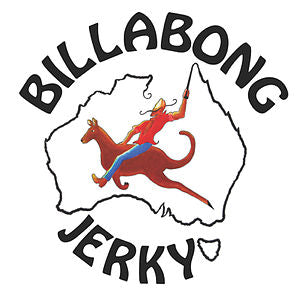A Bit About Us
Since 1993, we’ve been proudly making high-quality Australian jerky from our purpose-built facility in Cootamundra, regional NSW. Designed specifically for jerky production, our factory was one of the first of its kind in the country—built with a clear purpose: to create the best jerky Australia has to offer.
For years, our jerky has been a favourite among tourists in duty-free stores, proudly showcasing premium Australian meat and ingredients to the world. Now, we’re bringing that same quality home with the launch of our snack pack range, making it easier than ever for Australians to enjoy our jerky, wherever they are.
We don’t cut corners—on ingredients, on process, or on quality. When you buy from Billabong Jerky, you're getting nothing but the best.
Our Recipe for Great Jerky
We use grass-fed beef sourced from the wide, open expanses of the Australian outback. Naturally lean and free from hormones, antibiotics, or chemicals, it’s the perfect foundation for great jerky.
Each batch is marinated for 14 hours in a carefully crafted blend of herbs, spices, and locally grown, cold-pressed canola oil, delivering a rich, balanced flavour that lasts.
World-class production
-
Quality & Safety
Our factory is export registered and operates under a rigorous HACCP-based quality assurance program, with every step monitored and audited to ensure food safety and consistent, premium-quality jerky.
-
From Farm to Pack
Every pack of jerky can be traced back to the exact day it was made, where the meat came from, even down to the specific paddock, thanks to strict traceability systems used in both our factory and partnering abattoirs.
-
Scalable Production
With upgraded drying tunnels, independent product testing, and our own refrigerated truck fleet, we produce over 4 tonnes of jerky weekly while maintaining full control over ingredient sourcing and delivery logistics.
Got an appetite for more?
Sustainability at Billabong Jerky
As a family-owned business, we live by the belief that “those who die with the most grandchildren, die richest.” That means looking after the environment we’ll leave to them.
Living in regional NSW, we’re closely connected to the land. We see firsthand the effects of changing rainfall and hotter summers. While the debate around climate change continues, for us, it’s simple: if we can reduce our environmental impact, we should.
We’ve been committed to sustainability for over 30 years, making practical, meaningful changes like:
- grass-fed, free-range beef and kangaroo, which have a lower environmental footprint.
- 180-panel solar system and solar hot water to cut down on energy use.
- efficient drying tunnels to reduce gas consumption.
We’re working toward battery storage to further reduce grid reliance and exploring ways to heat our drying tunnels with solar energy.
We know we’re just one business, but small efforts add up. And we’re proud to do our part.
A Brief History of Jerky
Drying meat is one of the oldest and most effective ways to preserve food, used by nearly every ancient culture across the globe. From smoky fireside discoveries to long voyages and harsh winters, jerky has helped people travel, survive, and thrive for thousands of years.
Salt was an early game-changer, improving both preservation and taste. Later came sugar, honey, herbs, and spices, each culture adding their own twist. From South America’s “charqui” to South Africa’s “biltong,” and Native American pemmican to cowboy saddlebag snacks, jerky has taken on many names and styles.
As European explorers set out across oceans, they carried jerky (or salted meat) with them. And wherever the Americans went, especially post-WWII, so did their version of jerky. Today, it’s found in pantries around the world.
In Australia, our Indigenous people didn’t develop a tradition of jerky, mainly because animals like kangaroos could be eaten fresh, and their sustainable land management ensured a constant food supply. European settlers, on the other hand, often relied on salt beef during long treks, except for the famed explorer Ludwig Leichhardt, who preferred jerky.
Modern jerky is now more than survival food. With growing awareness around diet and wellness, jerky has become a high-protein, low-carb staple embraced by fitness lovers, Paleo and Keto eaters, and anyone seeking real, unprocessed food. And yes, it still tastes great.
The Art of Eating Jerky
The longer you chew jerky, the more satisfying and filling it becomes. That’s part of the magic.
Traditional jerky is cut thick and dried slowly, not cooked. Unlike many commercial brands that heat jerky at high temperatures (which breaks down connective tissue for easier chewing), true jerky retains its texture. This gives you something to chew on, long after the flavour fades, much like natural chewing gum.
In the past, jerky wasn’t just preserved protein. It was a travel companion. As you walked, paddled or rode, chewing released saliva, mixing with the meat to create a hearty, protein-rich “soup” that kept you going. Its slow digestion meant lasting energy and fullness, no snack bars needed.
Jerky isn’t just something you eat, it’s something you experience.
